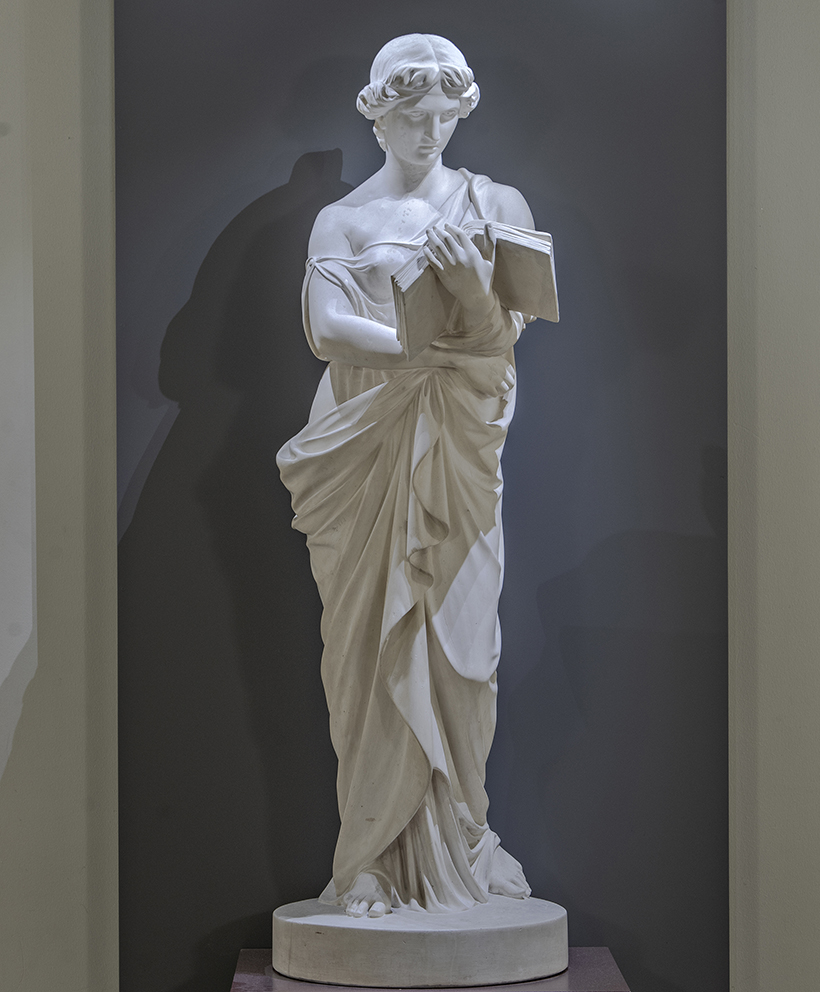A female figure cast in plaster stands engrossed in the book she is holding in her left hand. In her right hand she has a pen for taking notes. The other side of her draped garment has fallen down her shoulder. Her hair has been curled at the front and tied up at the neck. Our object of the month is a sculpture known by its German title Wissenschaft (‘Science’). It depicts a woman standing in the contrapposto pose on a plinth, much like an ancient goddess.

From Berlin to Helsinki
As its name suggests, Wissenschaft is of German origin. It was created by sculptor Alexander Tondeur, who was born in 1829 in Berlin, where his father Wilhelm Tondeur worked as a merchant. He initially studied at the Academy of Arts in Berlin and under the tutelage of sculptor Gustav Bläser. In the 1850s he continued his studies abroad, first in Vienna for a few years, then in Paris and later in Rome. He returned to his hometown of Berlin to pursue his career and became known for his impressive half-length portraits and his mythological and allegorical sculptures. Tondeur died in Schöneberg near Berlin in 1905.
Little is known about Wissenschaft, one of Tondeur’s allegorical works. We do not know whether the original work created by the artist still exists or whether our plaster version is the only remaining copy, or even when the sculpture was created. We can surmise that it is from the 1870s, as a stereoscope image from 1876 depicting Wissenschaft is included in the Rijksmuseum collections in the Netherlands.

The Imperial Alexander University of Helsinki acquired the sculpture in 1891 from the Berlin-based Gebrüder Micheli company, established in 1824. Operating on the Unter den Linden boulevard, the company was one of the finest purveyors of plaster copies in Berlin, selling them as both home decorations and models for artists. The company’s detailed catalogue presents plaster copies of ancient sculptures and anatomical casts of hands and feet intended to be used as models for drawing.

Wissenschaft was initially placed in the entrance hall of the Arppeanum building. Designed by Carl Albert Edelfelt as a chemistry laboratory and University museum building, Arppeanum had been completed in 1869.

In the 1900s Wissenschaft was moved from Arppeanum to the Main Building and back, possibly together with the University’s art-historical sculpture collection, despite not being part of it. When the Helsinki University Museum was opened in Arppeanum in 2003, the sculpture returned there. It continued to welcome visitors to the building until 2014 when it was relocated to the museum’s new facilities in the Main Building.
Symbolism and academic art
Wissenschaft is not an example of the contemporary art of its time, but a typical piece of academic art. During the period of neoclassicism in the late 18th century and the early 19th century, artists sought inspiration from ancient times. The influential Académie des Beaux-Arts in France impacted art teaching and artists, showing the way for the rest of Europe. The works receiving prizes in the Salon, the Académie’s official art exhibition, had mythological motifs or an erotic undertone. In the late 19th century, however, academic art with its classical regularities began to give way to avant-garde tendencies. New styles, such as impressionism and expressionism, took over. Tondeur, however, appears to have continued with his academic style.
Wissenschaft is a symbolic work, an allegory. In allegorical art, abstract concepts, forces of nature and emotions are personified by depicting them as human or animal figures with attributes that convey the intended message. The woman and the book are both common motifs in allegorical art. The book has been used to symbolise wisdom, teaching and knowledge, whereas the female figure has often served as a symbol of an idea or principle. The inspiration for Wissenschaft may have come from Clio, the ancient muse of history, who is often depicted holding a book or scrolls and a pen. One of the most famous Finnish allegorical sculptures is Walter Runeberg’s Lex from 1894. In it, the maiden of Finland, carrying a sword and a shield and wearing a bearskin, symbolises law.

In its strategic plan, the University of Helsinki pledges to harness the power of knowledge to build a better world. As a symbol of science, Wissenschaft is perfectly suited to the University art collection.
This artwork will be included in the museum’s new core exhibition, to be opened in the University of Helsinki Main Building in autumn 2023.
Katariina Pehkonen, Curator
Translation: University of Helsinki Language Services.
Sources:
Kati Heinämies (Ed., 2003): Helsingin yliopistomuseo: tiedettä, taidetta, historiaa
Frank Matthias Kammel (2001): Der Gipsabguss. Vom Medium der ästhetischen Norm zur toten Konserve der Kunstgeschichte.
Steven Olderr (1986): Symbolism: A Comprehensive Dictionary
Veikko Pakkanen (1981): Keisarillisen Aleksanterin-yliopiston kemian laboratorio- ja museorakennus Helsingissä
Marilyn Stokstad & Michael Watt Cothren (2014): Art history
Alexander Tondeur, Nordisk familjebok: http://runeberg.org/nfci/0187.htm, accessed 11 April 2023
Art term – Allegory: https://www.tate.org.uk/art/art-terms/a/allegory, accessed 11 April 2023
HAM – Aleksanteri II: https://www.hamhelsinki.fi/veistos/aleksanteri-ii/, accessed 9 June 2023
